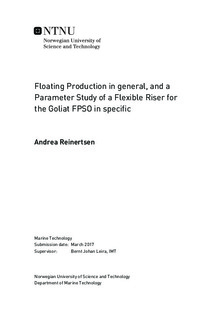| dc.description.abstract | A floating production system (FPS) consists of a floating structure, a mooring system, anchors and risers. Such systems enable production for larger ocean depths. Risers are vertical pipes used for transportation of production fluids between the seabed and the production unit. FPS and its components are presented and discussed in this thesis. Using an FPS entails certain challenges; risers, for instance, need other properties than for fixed structures, as they will hang from the floating unit, and must be able to absorb vessel movement. FPS is also a good option in remote areas with little infrastructure, as for the Barents Sea. When operating in arctic areas, additional challenges connected to the environment must be considered. In this thesis, challenges such as darkness, low temperatures and ice issues are identified and categorised.
The Goliat field is the first operating field to start production of oil in arctic areas. At this field, a circular Floating Production, Storage and Offloading (FPSO) unit operates, and it is equipped with flexible risers. A model of this circular FPSO is modeled as a uniform cylinder with a draught of 32.2 metres. A 644 metre long steep wave flexible riser is modelled to span between the platform and the seabed in the 400 metre deep water. A parameter study is performed to investigate the influence on the riser response. The analyses are performed in RILFEX, a software utilized for static and dynamic analysis of slender marine structures. The varying parameters are the current profile, the riser diameter and the drag coefficient.
An analysis for varying horizontal offset of the platform, relative to the riser's touch down point (TDP) on the seabed, is also performed. The platform position that results in lowest effective tension in the riser, is 250 metres away from TDP. For this case, the riser also has lowest response amplitude.
Analyses are performed for three current profiles, uniform current, linear current and no current. It is found that by increasing the current, curvature near the riser top decreases. The case where linear current is applied, the largest tension in the riser occurs. Current variation also leads to change in the vertical displacement. For the case with no current, the riser top has a larger displacement in the negative z-direction, compared to the cases when current is applied.
The next parameter subject to change is the diameter, and three cases were studied. For increasing diameter, the weight is also increased, and the additional buoyancy due to increased volume, does not even out the added weight. As a consequence, some results might be affected more by the weight change, rather than by the change of diameter. Regarding curvature and tension, the two risers with largest diameter and weight behaves similarly, compared to the smallest riser. The two largest diameters experience larger tension and have less curvature at the hangoff, which corresponds with the additional weight.
The last parameter that was studied was the drag coefficient. For variation in diameter and drag, the displacement in vertical direction is only slightly affected near the riser top. As it is the riser properties that are changed, rather than external loading, the vessel motion is not significantly affected. The vertical displacement of the riser is affected more by change of riser properties at positions further from the vessel. | |

